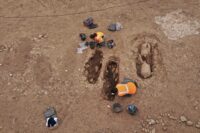 A late Imperial necropolis has been discovered in the center of the two of l’Île-Rousse on the western coast of northern Corsica. The burial pits were dug out of the rock and filled with different styles of grave. About 40 graves have been found, the majority of them amphora burials in which large storage amphorae were used as coffins. There are also some tile burials, where recycled edged roof tiles (tegulae) and joint covers (imbrices) were perched over the deceased.
A late Imperial necropolis has been discovered in the center of the two of l’Île-Rousse on the western coast of northern Corsica. The burial pits were dug out of the rock and filled with different styles of grave. About 40 graves have been found, the majority of them amphora burials in which large storage amphorae were used as coffins. There are also some tile burials, where recycled edged roof tiles (tegulae) and joint covers (imbrices) were perched over the deceased.
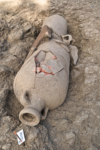 There is evidence of human settlement at the site going back to the Neolithic and the Phoenician colony of Agilla was established was at the site by 1000 B.C. After the fall of Tyre to the Babylonian king Nebuchadnezzar in the 6th century B.C., Carthage stepped into the power vacuum and took over support of its former dependencies, including the ones in Corsica. That ended with the Roman conquest of Corsica in the First Punic War in 238 B.C. Agilla became the Roman town of Rubico Rocega for the next 600 years.
There is evidence of human settlement at the site going back to the Neolithic and the Phoenician colony of Agilla was established was at the site by 1000 B.C. After the fall of Tyre to the Babylonian king Nebuchadnezzar in the 6th century B.C., Carthage stepped into the power vacuum and took over support of its former dependencies, including the ones in Corsica. That ended with the Roman conquest of Corsica in the First Punic War in 238 B.C. Agilla became the Roman town of Rubico Rocega for the next 600 years.
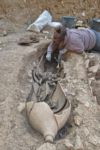 After the fall of the Western Empire, Rubico Rocega was largely abandoned, used by smugglers and fishermen, until the founding of l’Île-Rousse in the mid-18th century. Very few remains from the Phoenician and Roman towns have been found, and this is the first archaeological excavation of the center of the modern city and the first precise confirmation that the Roman city was located at the site of modern-day of l’Île-Rousse.
After the fall of the Western Empire, Rubico Rocega was largely abandoned, used by smugglers and fishermen, until the founding of l’Île-Rousse in the mid-18th century. Very few remains from the Phoenician and Roman towns have been found, and this is the first archaeological excavation of the center of the modern city and the first precise confirmation that the Roman city was located at the site of modern-day of l’Île-Rousse.
The evidence from the necropolis demonstrates that the Roman city still had strong trade links to North Africa. The amphorae from the burials were 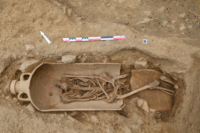 mostly manufactured in Carthage, now a Roman province and the primary source of wine and olive oil imports to Corsica in the 4th century A.D.
mostly manufactured in Carthage, now a Roman province and the primary source of wine and olive oil imports to Corsica in the 4th century A.D.
No grave goods or funerary offerings have been found. The burials are oriented west-east, with the heads on the west side and feet to the east. The skeletal remains are not in great condition and there has been significant deterioration of the surfaces of the burial pits caused by the development of the town in the 19th century. The Church of the Immaculate Conception, completed in 1893, was built right next to the necropolis, and there was copious infilling done at the time to level out the slope of the hill.
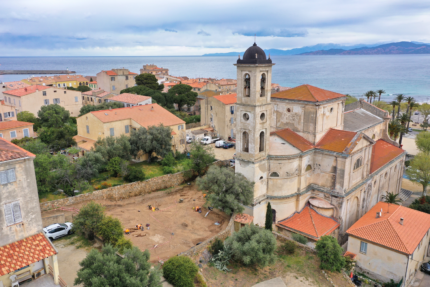
The Vandals under Genseric (a.k.a Geiseric) crossed to Africa in 429AD. According to Procopius, the Vandals came to Africa at the request of Bonifacius, the renegade military ruler of the region. Although primarily remembered for the sack of Rome in 455 and their persecution of Nicene Christians in favor of Arian Christianity, the Vandals were also patrons of learning. Grand building projects continued, schools flourished, and North Africa fostered many of the most innovative writers and natural scientists of the late Latin-speaking Western Roman Empire.
Flavius Sigisvultus (whose name looks suspiciously Gothic) had been sent in 427 to command the war in Africa against the rebellious general, Bonifacius, and after previous generals had been defeated by the latter, Sigisvult may have been appointed comes Africae, succeeding Bonifacius. Sigisvult seized Hippo and Carthage, and as an Arian himself, sent an Arian bishop, Maximinus, to dispute with Augustinus of Hippo in 427 or 428. He presumably returned to Italy after relations between the Emperor and Bonifacius were restored in 429.
In other words, it would be great to know if the church building of the Immaculate Conception, when it was completed in 1893, was built next to that necropolis by sheer accident, or if there had been an earlier religious building or church, and therefore the location of that necropolis with its ‘pithos’ burials oriented west-east, with the heads on the west side and feet to the east, is maybe not so coincidental as it may seem.
:hattip:
——–
“In the commune of Ile-Rousse, at the foot of the church of the Immaculate Conception, INRAP has just uncovered some forty tombs dating from the 3rd – 6th centuries AD. The deceased are buried mostly inside large amphorae from Tunisia.”
——–
In the final phase of the Western Roman Empire, in the 5th century AD, battles began between Vandals and Goths over [not only] Corsica, in which indeed the Vandal king Geiseric emerged victorious (in 477AD, he died in Carthage).
After the conquest of Italy by the Eastern Roman Empire, the island became part of the ‘Exarchate of Carthage’ in 536AD.
cf. also: en.wikipedia.org/wiki/Vandalic_War#Roman–Vandal_relations_until_533
How did they get the bodies in the amphorae?
Coolest burial idea I have ever seen.
Virginia: It is hard to say how it was always done from the few pictures there are, but the essence seems to be that you get yourself two amphora, cut the base off one and the top off the other, slide the body feet first into the base one, and then slide the body and base amphora into the top amphora.
These days someone making a YouTube video would buy twenty to practice on, use some fancy blade in a jigsaw with plenty of water cooling, cut an opening in the front of one, add some kind of hidden hinge and a magnetic lock, then line the interior in some fancy gear – and pretend they used only one amphora. Which might be pretty much the modern equivalent of what they achieved back then.